Page 546 of 705
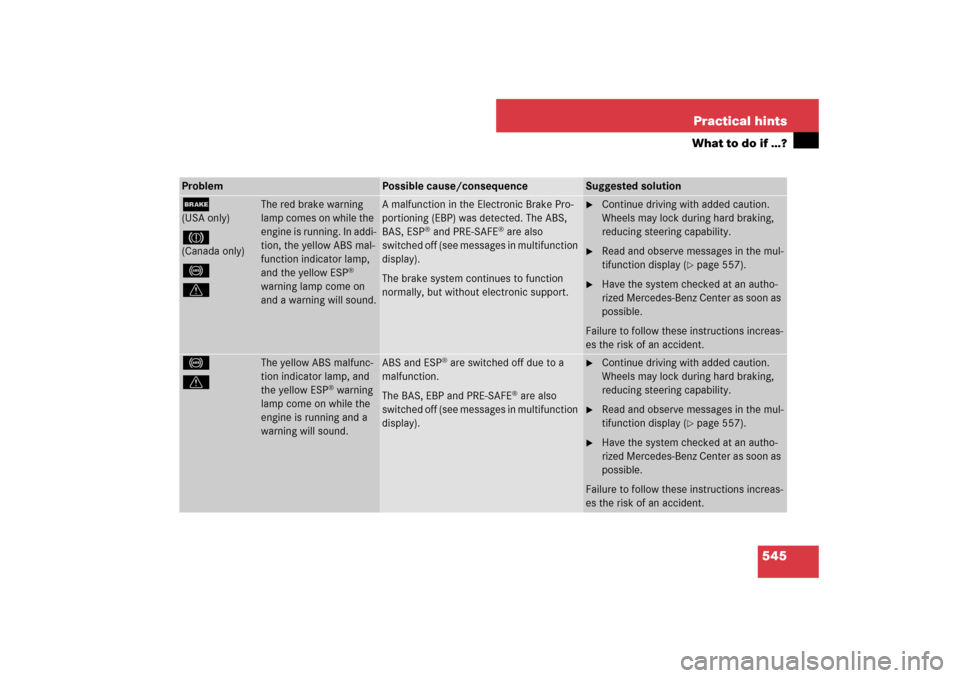
545 Practical hints
What to do if …?
Problem
Possible cause/consequence
Suggested solution
;(USA only)3(Canada only)-
v
The red brake warning
lamp comes on while the
engine is running. In addi-
tion, the yellow ABS mal-
function indicator lamp,
and the yellow ESP
®
warning lamp come on
and a warning will sound.
A malfunction in the Electronic Brake Pro-
portioning (EBP) was detected. The ABS,
BAS, ESP
® and PRE-SAFE
® are also
switched off (see messages in multifunction
display).
The brake system continues to function
normally, but without electronic support.
�
Continue driving with added caution.
Wheels may lock during hard braking,
reducing steering capability.
�
Read and observe messages in the mul-
tifunction display (
�page 557).
�
Have the system checked at an autho-
rized Mercedes-Benz Center as soon as
possible.
Failure to follow these instructions increas-
es the risk of an accident.
-
v
The yellow ABS malfunc-
tion indicator lamp, and
the yellow ESP
® warning
lamp come on while the
engine is running and a
warning will sound.
ABS and ESP
® are switched off due to a
malfunction.
The BAS, EBP and PRE-SAFE
® are also
switched off (see messages in multifunction
display).
�
Continue driving with added caution.
Wheels may lock during hard braking,
reducing steering capability.
�
Read and observe messages in the mul-
tifunction display (
�page 557).
�
Have the system checked at an autho-
rized Mercedes-Benz Center as soon as
possible.
Failure to follow these instructions increas-
es the risk of an accident.
Page 547 of 705
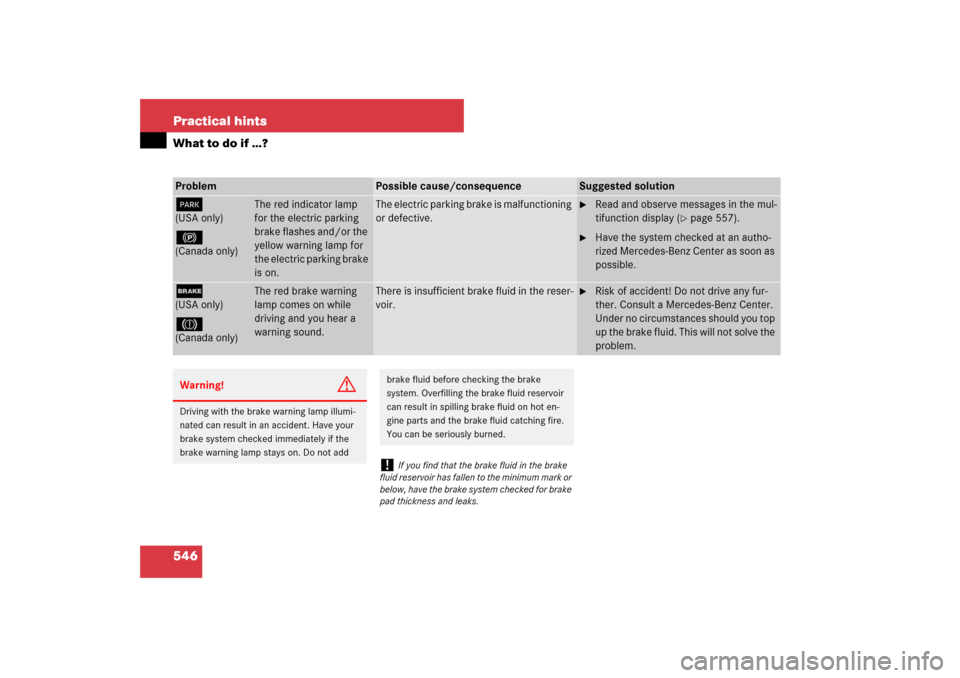
546 Practical hintsWhat to do if …?Problem
Possible cause/consequence
Suggested solution
0(USA only)!(Canada only)
The red indicator lamp
for the electric parking
brake flashes and/or the
yellow warning lamp for
the electric parking brake
is on.
The electric parking brake is malfunctioning
or defective.
�
Read and observe messages in the mul-
tifunction display (
�page 557).
�
Have the system checked at an autho-
rized Mercedes-Benz Center as soon as
possible.
;(USA only)3(Canada only)
The red brake warning
lamp comes on while
driving and you hear a
warning sound.
There is insufficient brake fluid in the reser-
voir.
�
Risk of accident! Do not drive any fur-
ther. Consult a Mercedes-Benz Center.
Under no circumstances should you top
up the brake fluid. This will not solve the
problem.
Warning!
G
Driving with the brake warning lamp illumi-
nated can result in an accident. Have your
brake system checked immediately if the
brake warning lamp stays on. Do not add
brake fluid before checking the brake
system. Overfilling the brake fluid reservoir
can result in spilling brake fluid on hot en-
gine parts and the brake fluid catching fire.
You can be seriously burned.!
If you find that the brake fluid in the brake
fluid reservoir has fallen to the minimum mark or
below, have the brake system checked for brake
pad thickness and leaks.
Page 548 of 705
547 Practical hints
What to do if …?
Problem
Possible cause/consequence
Suggested solution
±
The yellow engine malfunc-
tion indicator lamp comes
on while driving.
There is a malfunction in:�
The fuel management system
�
The ignition system
�
The emission control system
�
Systems which affect emissions
Such malfunctions may result in excessive
emissions values and may switch the en-
gine to its limp-home (emergency opera-
tion) mode.
�
Have the vehicle checked as soon as
possible by an authorized
Mercedes-Benz Center.
An on-board diagnostic connector is
used by the service station to link the
vehicle to the shop diagnostics system.
It allows the accurate identification of
system malfunctions through the read-
out of diagnostic trouble codes. It is lo-
cated in the front left area of the
footwell.
i
Some states may by law require you to visit
a workshop immediately as soon as the engine
malfunction indicator lamp comes on. Check lo-
cal requirements.
Page 551 of 705
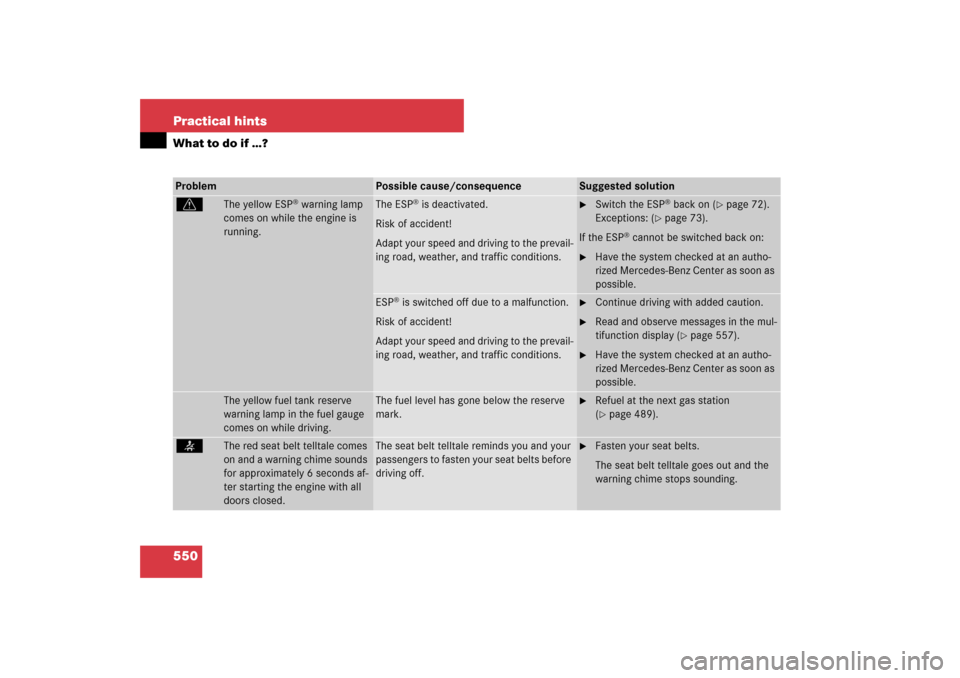
550 Practical hintsWhat to do if …?Problem
Possible cause/consequence
Suggested solution
v
The yellow ESP
® warning lamp
comes on while the engine is
running.
The ESP
® is deactivated.
Risk of accident!
Adapt your speed and driving to the prevail-
ing road, weather, and traffic conditions.
�
Switch the ESP
® back on (
�page 72).
Exceptions: (
�page 73).
If the ESP
® cannot be switched back on:
�
Have the system checked at an autho-
rized Mercedes-Benz Center as soon as
possible.
ESP
® is switched off due to a malfunction.
Risk of accident!
Adapt your speed and driving to the prevail-
ing road, weather, and traffic conditions.
�
Continue driving with added caution.
�
Read and observe messages in the mul-
tifunction display (
�page 557).
�
Have the system checked at an autho-
rized Mercedes-Benz Center as soon as
possible.
The yellow fuel tank reserve
warning lamp in the fuel gauge
comes on while driving.
The fuel level has gone below the reserve
mark.
�
Refuel at the next gas station
(�page 489).
<
The red seat belt telltale comes
on and a warning chime sounds
for approximately 6 seconds af-
ter starting the engine with all
doors closed.
The seat belt telltale reminds you and your
passengers to fasten your seat belts before
driving off.
�
Fasten your seat belts.
The seat belt telltale goes out and the
warning chime stops sounding.
Page 553 of 705
552 Practical hintsWhat to do if …?Problem
Possible cause/consequence
Suggested solution
=
The red SRS indicator lamp
comes on while the engine is
running.
There is a malfunction in the supplemental
restraint systems. The air bags or emergen-
cy tensioning devices (ETDs) could deploy
unexpectedly or fail to activate in an acci-
dent.
�
Drive with added caution to the nearest
authorized Mercedes-Benz Center.
Warning!
G
In the event a malfunction of the SRS is indi-
cated as outlined above, the SRS may not be
operational. For your safety, we strongly
recommend that you visit an authorized
Mercedes-Benz Center immediately to have
the system checked; otherwise the SRS may
not be activated when needed in an acci-
dent, which could result in serious or fatal
injury, or it might deploy unexpectedly and
unnecessarily which could result in an acci-
dent and/or injury to you or to others.
Page 554 of 705
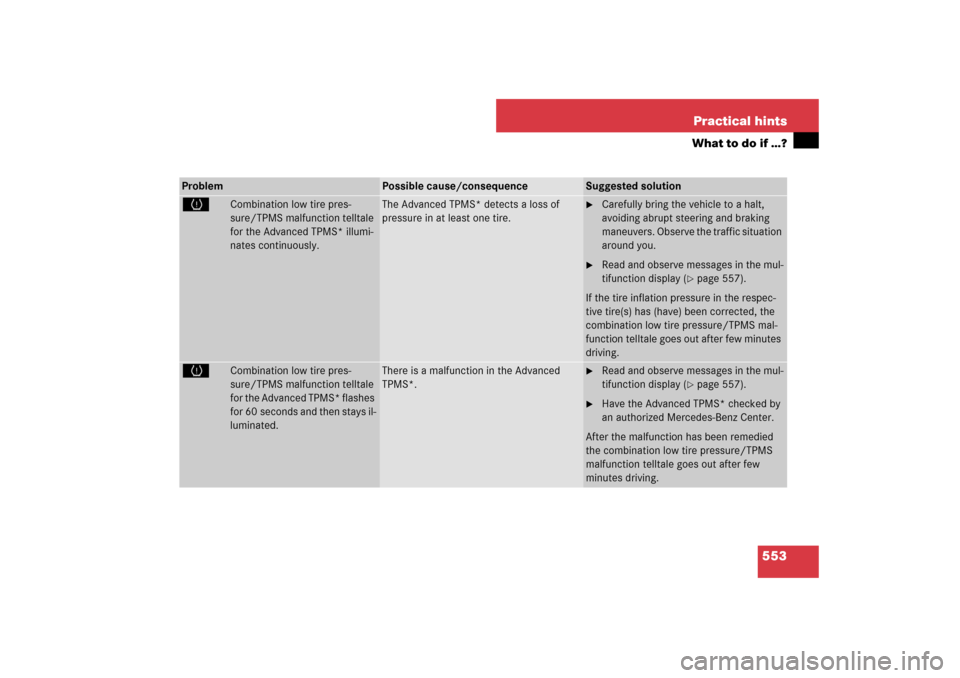
553 Practical hints
What to do if …?
Problem
Possible cause/consequence
Suggested solution
H
Combination low tire pres-
sure/TPMS malfunction telltale
for the Advanced TPMS* illumi-
nates continuously.
The Advanced TPMS* detects a loss of
pressure in at least one tire.
�
Carefully bring the vehicle to a halt,
avoiding abrupt steering and braking
maneuvers. Observe the traffic situation
around you.
�
Read and observe messages in the mul-
tifunction display (
�page 557).
If the tire inflation pressure in the respec-
tive tire(s) has (have) been corrected, the
combination low tire pressure/TPMS mal-
function telltale goes out after few minutes
driving.
H
Combination low tire pres-
sure/TPMS malfunction telltale
for the Advanced TPMS* flashes
for 60 seconds and then stays il-
luminated.
There is a malfunction in the Advanced
TPMS*.
�
Read and observe messages in the mul-
tifunction display (
�page 557).
�
Have the Advanced TPMS* checked by
an authorized Mercedes-Benz Center.
After the malfunction has been remedied
the combination low tire pressure/TPMS
malfunction telltale goes out after few
minutes driving.
Page 555 of 705
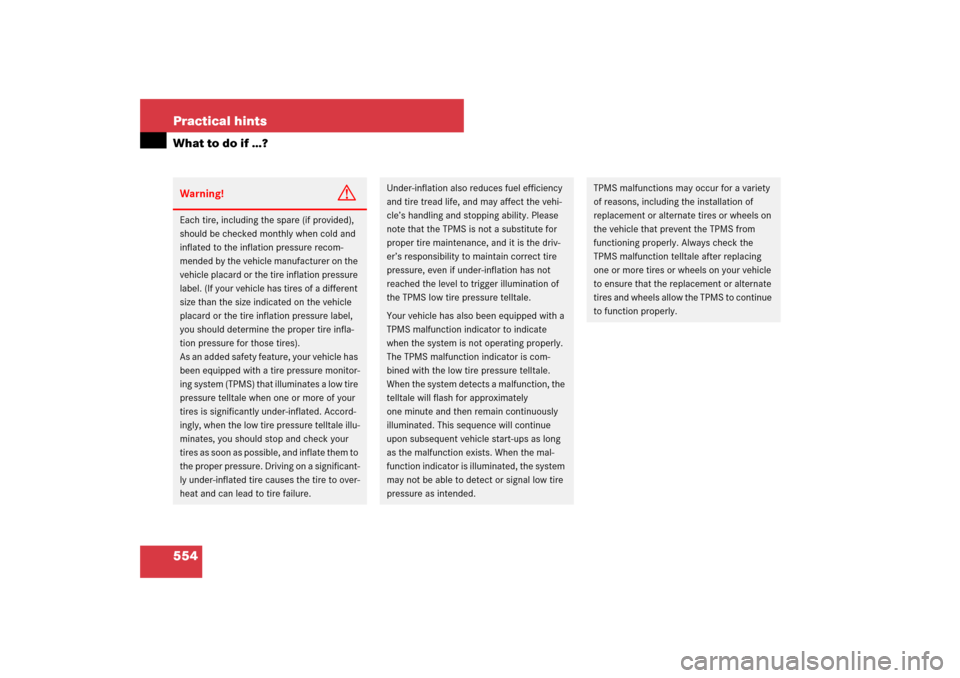
554 Practical hintsWhat to do if …?Warning!
G
Each tire, including the spare (if provided),
should be checked monthly when cold and
inflated to the inflation pressure recom-
mended by the vehicle manufacturer on the
vehicle placard or the tire inflation pressure
label. (If your vehicle has tires of a different
size than the size indicated on the vehicle
placard or the tire inflation pressure label,
you should determine the proper tire infla-
tion pressure for those tires).
As an added safety feature, your vehicle has
been equipped with a tire pressure monitor-
ing system (TPMS) that illuminates a low tire
pressure telltale when one or more of your
tires is significantly under-inflated. Accord-
ingly, when the low tire pressure telltale illu-
minates, you should stop and check your
tires as soon as possible, and inflate them to
the proper pressure. Driving on a significant-
ly under-inflated tire causes the tire to over-
heat and can lead to tire failure.
Under-inflation also reduces fuel efficiency
and tire tread life, and may affect the vehi-
cle’s handling and stopping ability. Please
note that the TPMS is not a substitute for
proper tire maintenance, and it is the driv-
er’s responsibility to maintain correct tire
pressure, even if under-inflation has not
reached the level to trigger illumination of
the TPMS low tire pressure telltale.
Your vehicle has also been equipped with a
TPMS malfunction indicator to indicate
when the system is not operating properly.
The TPMS malfunction indicator is com-
bined with the low tire pressure telltale.
When the system detects a malfunction, the
telltale will flash for approximately
one minute and then remain continuously
illuminated. This sequence will continue
upon subsequent vehicle start-ups as long
as the malfunction exists. When the mal-
function indicator is illuminated, the system
may not be able to detect or signal low tire
pressure as intended.
TPMS malfunctions may occur for a variety
of reasons, including the installation of
replacement or alternate tires or wheels on
the vehicle that prevent the TPMS from
functioning properly. Always check the
TPMS malfunction telltale after replacing
one or more tires or wheels on your vehicle
to ensure that the replacement or alternate
tires and wheels allow the TPMS to continue
to function properly.
Page 556 of 705
555 Practical hints
What to do if …?
Air bag off indicator lampProblem
Possible cause/consequence
Suggested solution
59The front passenger front
air bag off indicator lamp
illuminates and remains il-
luminated with the weight
of a typical adult or some-
one larger than a small in-
dividual on the front
passenger seat.
The system is malfunctioning.
�
Have the system checked as soon as possible by an authorized
Mercedes-Benz Center.
�
Also read and observe any messages in the multifunction display
and follow corrective steps (
�page 564).
Warning!
G
If the59indicator lamp
illuminates and remains illuminated with the
weight of a typical adult or someone larger
than a small individual on the front passen-
ger seat, do not have any passenger use the
front passenger seat until the system has
been repaired.